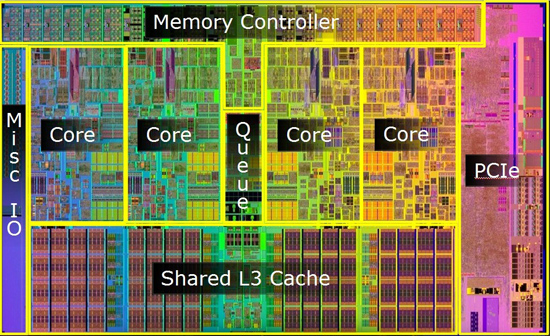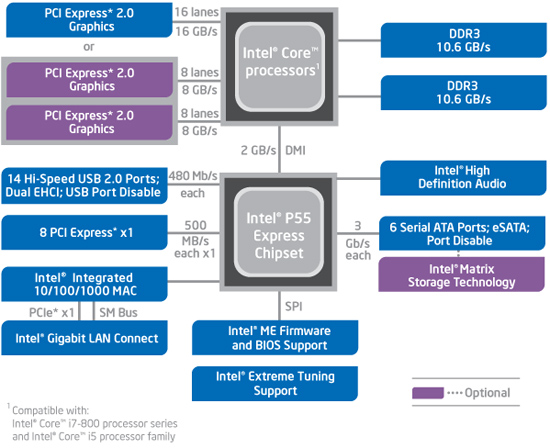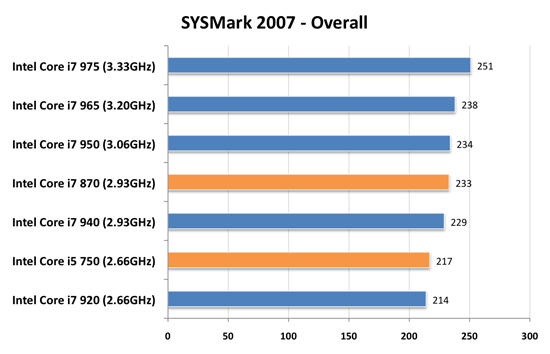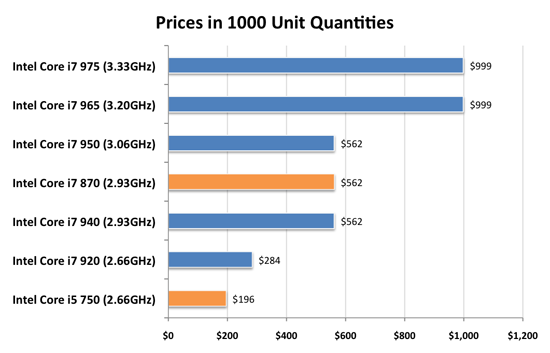Intel's Core i7 870 & i5 750, Lynnfield: Harder, Better, Faster Stronger
by Anand Lal Shimpi on September 8, 2009 12:00 AM EST- Posted in
- CPUs
Intel is on the verge of transitioning to 32nm. We'll see the first parts this year. What do you do with your 45nm fabs when you start moving volume away from them? Make really cheap quad-core Nehalems of course:

I'm talking $196. I'm talking faster than AMD's entire lineup. I'm talking about arguably the best processor of 2009. I'm talking about Lynnfield, and here's its backside:

Mmm
I spent much of the past year harping on AMD selling Nehalem-sized Phenom IIs for less than Intel sold Nehalems. With Lynnfield, Intel actually made Nehalem even bigger all while driving prices down. Like I said, what do you do when you're still making boatloads of money in a recession and are about to start emptying your 45nm fabs?
I should clear things up before we progress much further. Lynnfield is the codename for mainstream 45nm quad-core Nehalem, while Bloomfield refers to the first Nehalem launched at the end of 2008:
| Processor | Manufacturing Process | Die Size | Transistor Count | Socket |
| Bloomfield | 45nm | 263 mm2 | 731M | LGA-1366 |
| Lynnfield | 45nm | 296 mm2 | 774M | LGA-1156 |
Despite being cheaper, Lynnfield is larger than Bloomfield. The larger die is due to one major addition: an on-die PCIe controller.

Bloomfield, The First Nehalem, circa 2008

Lynnfield, Nehalem for All, circa 2009
The pink block to the right of the die is the PCIe controller, that's 16 PCIe 2.0 lanes coming right off the chip. Say hello to ultra low latency GPU communication. You'd think that Intel was about to enter the graphics market or something with a design like this.
Sacrifices were made to reduce CPU, socket and board complexity. Gone are the two QPI links that each provided 25.6GB/s of bandwidth to other CPUs or chips on the motherboard. We also lose one of the three 64-bit DDR3 memory channels, Lynnfield only has two like a normal processor (silly overachieving Bloomfield).

Intel's Bloomfield Platform (X58 + LGA-1366)
The sum is that Lynnfield is exclusively single-socket; there will be no LGA-1156 Skulltrail. While the dual-channel memory controller isn't really a limitation for quad-core parts, six and eight core designs may be better suited for LGA-1366.

Intel's Lynnfield Platform (P55 + LGA-1156)
The loss of QPI means that Lynnfield doesn't have a super fast connection to the rest of the system, but with an on-die PCIe controller it doesn't matter: the GPU is fed right off the CPU.
The Lineup
We get three Lynnfield CPUs today: the Core i7 870, Core i7 860 and the Core i5 750. Intel's branding folks told us that the naming would make sense one we saw the rest of the "Core" parts introduced; yeah that was pretty much a lie. At least there aren't any overlapping part numbers (e.g. Core i5 860 and Core i7 860).
The i7 in this case denotes four cores + Hyper Threading, the i5 means four cores but no Hyper Threading. The rules get more complicated as you bring notebooks into the fray but let's momentarily bask in marginal simplicity.
| Processor | Clock Speed | Cores / Threads | Maximum Single Core Turbo Frequency | TDP | Price |
| Intel Core i7-975 Extreme | 3.33GHz | 4 / 8 | 3.60GHz | 130W | $999 |
| Intel Core i7 965 Extreme | 3.20GHz | 4 / 8 | 3.46GHz | 130W | $999 |
| Intel Core i7 940 | 2.93GHz | 4 / 8 | 3.20GHz | 130W | $562 |
| Intel Core i7 920 | 2.66GHz | 4 / 8 | 2.93GHz | 130W | $284 |
| Intel Core i7 870 | 2.93GHz | 4 / 8 | 3.60GHz | 95W | $562 |
| Intel Core i7 860 | 2.80GHz | 4 / 8 | 3.46GHz | 95W | $284 |
| Intel Core i5 750 | 2.66GHz | 4 / 4 | 3.20GHz | 95W | $196 |
Keeping Hyper Threading off of the Core i5 is purely done to limit performance. There aren't any yield reasons why HT couldn't be enabled.
Intel was very careful with both pricing and performance of its Lynnfield processors. I'm going to go ahead and say it right now, there's no need for any LGA-1366 processors slower than a Core i7 965:

This is only one benchmark, but it's representative of what you're about to see. The Core i7 870 (LGA-1156) is as fast, if not faster, than every single LGA-1366 processor except for the ones that cost $999. Its pricing is competitive as well:

For $196 you're getting a processor that's faster than the Core i7 920. I'm not taking into account motherboard prices either, which are anywhere from $50 - $100 cheaper for LGA-1156 boards. I don't believe LGA-1366 is dead, but there's absolutely no reason to buy anything slower than a 965 if you're going that route.










343 Comments
View All Comments
nikrusty - Wednesday, November 18, 2009 - link
With this article Anandtech is Harder, Better, Faster Stronger.Seriously AWESOME ARTICLE! It cleared many of my doubts FLAT OUT! Now I know i5 is the way to go especially becoz I dont care about overclocking and just want good gaming performance...nothing screamingly extreme. Budget + Performance always keeps you level headed.
shiro - Wednesday, October 21, 2009 - link
what is that monster hoop of death heatsink that's on page 3? lolEeqmcsq - Saturday, September 19, 2009 - link
I asked a similar question in one of the other articles, so pardon me if this sounds repetitive.According to the Turbo charts, the slowest Turbo speed is higher than the stock speed. Why is that? For example, why not just make the 750 a stock GHz of 2.8 GHz instead of 2.66GHz?
Eeqmcsq - Saturday, September 19, 2009 - link
Argh, please ignore. Replied using the wrong Firefox tab.The0ne - Tuesday, September 15, 2009 - link
Clear up what you're trying to show on the graphs please. You're getting more FPS at max setting than at min settings? Label the graphs like you did with the others please. With the others I can just look and understand what you're doing. With these, I'm scratching my head.The0ne - Tuesday, September 15, 2009 - link
Ah, turbo mode represented in FPS >.>'kkara4 - Monday, September 14, 2009 - link
over at bittech.net, they are saying that it is more worth it to go for the i7-920, if we are considering anything above the i5. this is a conflicting story, since anand is recommending the lynnfields. anand or anybody else for that matter could you please see their articles and tell me what they have done wrong? (or perhaps you guys failed to see something). Your article explains things in great technical detail which i can understand since i have studied microprocessors, hence i am more inclined to go for lynnfield. anyway if someone could cross check that would be goodmapesdhs - Tuesday, September 15, 2009 - link
If I've understood Anand's analysis correctly, the conclusion is that,
for application mixes which involve a lot of single and/or dual-threaded
codes, and assuming one is not interested in high-end SLI/CF setups
or hard oc'ing all 4 cores all the time for tasks like video encoding
or animation rendering, the 750/860 are better buys because they
will internally push 1-core and 2-core clocks to a higher rate than
occurs with the 920 via the Turbo function, giving better results
than the 920, and of course the 750/860 are cheaper solutions
(although the 860 price is similar to the 920, the mbd costs less
than an X58, from what people say).
So it depends on what you want to use your system for. No interest
in CF/SLI? Running games that don't hammer 4 cores? An i5 750 or
i7 860 makes more sense. Using apps that don't use more than 2 cores?
Again the 750/860 is more logical, especially from a cost viewpoint.
This ties in with the other advantage of the X58 platform, ie. the
upgrade path to 6-core and 8-core CPUs. If this is something that
holds no value to you, then P55 makes more sense.
As always, it depends on what you want to use the system for. The
attraction of the 860 from a more general point of view is that it
also offers good quad-core performance when one does use all 4 cores
without sacrificing the traditional higher-clocks possible with
single or dual core setups when one is only using 1 or 2 cores. It's
the best of both worlds, at least for out-of-the-box functionality
anyway.
However, if one does intend to use all 4 cores almost all the time
(I do) with a strong overclock, then the 920 is a better choice
because of the voltage issue and (IMO) the 6/8-core upgrade path.
Likewise, high-end multi-GPU setups work better with X58.
Given that general usage of a PC rarely uses more than 2 cores, this
is why the 750 and 860 are such attractive options.
As for the 870, despite its 1/2-core speed advantages, the price is
too high IMO. For that kind of money, a 920 makes more sense, paired
with better cooling if one has such a spare budget, or buy a better
GPU setup which, for gaming, is where the real bottleneck lies.
Anand, please correct me if I'm wrong with the above.
Ian.
PS. As always, real-world pricing issues can make a mess of on-paper
technical conclusions. Also, although many games/apps don't exploit
more than 2 cores now, this is likely to change in the near future as
multi-core coding becomes more pervasive in the industry.
mapesdhs - Monday, September 14, 2009 - link
Anand/Gary,
Re your comments about an X58 advantage being the ability to use
later 6 and 8-core CPUs...
I've been planning to build an i7 920 system for video encoding, so
a max oc on all cores is useful to me; from the article I thus infer
the X58 is a better choice.
However, if I did buy such a setup instead of an i5 or i7 860, what
would the cost tradeoff be do you think when the 6-core CPUs arrive
with respect to upgrading? By that I mean, for total processing
throughput, do you reckon a 6-core upgrade would be significantly
cheaper than simply buying a second i7 920 setup? (gfx not an issue)
If not, then the ability to use 6/8-core CPUs later in this context
is somewhat lessened, something that would apply to animation
rendering aswell (ie. extra complete systems perhaps more cost
effective in increased overall throughput compared to upgrading to
more cores). Any ideas? Also, unless the applications used can
exploit more than 4 cores, the later 6-core CPUs won't help. I have
about 1500 hours of material to convert to DivX. Each file is about
40 to 45 minutes (documentary), so converting multiple files on
multiple systems at the same time is very doable.
Given the above, I'm looking forward to more details on how a max
oc'd i860/i870 compares to a max oc'd 920.
At present I'm just using a 6000+ setup to work out the appropriate
format/conversion paths.
Ian.
PS. May I suggest you don't bother replying to those moaning in such
an obviously ludicrous manner about the Turbo mode being active? I
have the distinct impression their posts are designed purely to
irritate. Please don't encourage them. Anyone with any sense will
read the article and understand the salient points you've highlighted
about Turbo mode being an integral function of the chip.
Milleman - Sunday, September 13, 2009 - link
I would say that i5 750 and Pehnom II X4 965 is fully comparable. AMD just have to adjust the pricetag and the price/performance will be on par. Looking at the Gaming rig performance, both i5 750 and Pehnom II X4 965 are well enough for gaming pleasure. I wouldn't shell out my bucks for the more expensive Intel top models. It's such a waste of money, unless you are working with huge video and image editing processes.